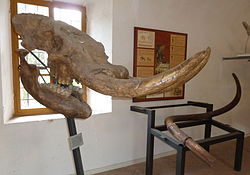Haplomastodon
|
Haplomastodon Temporal range: , 1.810–0.011 Ma |
|
|---|---|
 |
|
| Skull of H. chimborazi | |
| Scientific classification | |
| Kingdom: | Animalia |
| Phylum: | Chordata |
| Class: | Mammalia |
| Order: | Proboscidea |
| Family: | †Gomphotheriidae |
| Genus: |
†Haplomastodon Hoffstetter, 1950 |
Haplomastodon is an extinct genus of proboscidean endemic to South America during the from 1.810 Ma—11,000 years ago, living for approximately 1.789 million years.
It had two tusks on either side of a trunk like other members of Gomphotheriidae. Its apparent range was from Venezuela southward to Argentina where fossils were recovered in the Suelo Formation, a quarry dig in Corrientes Province. It may have shared its habit with Notiomastodon based on genus age and geography. Fossil remains of Haplomastodon waringi have been found in Soatá in the department of Boyacá in Colombia.
Haplomastodon was named by Hoffstetter (1950). It was assigned to Gomphotheriidae by Carroll (1988).
...
Wikipedia
